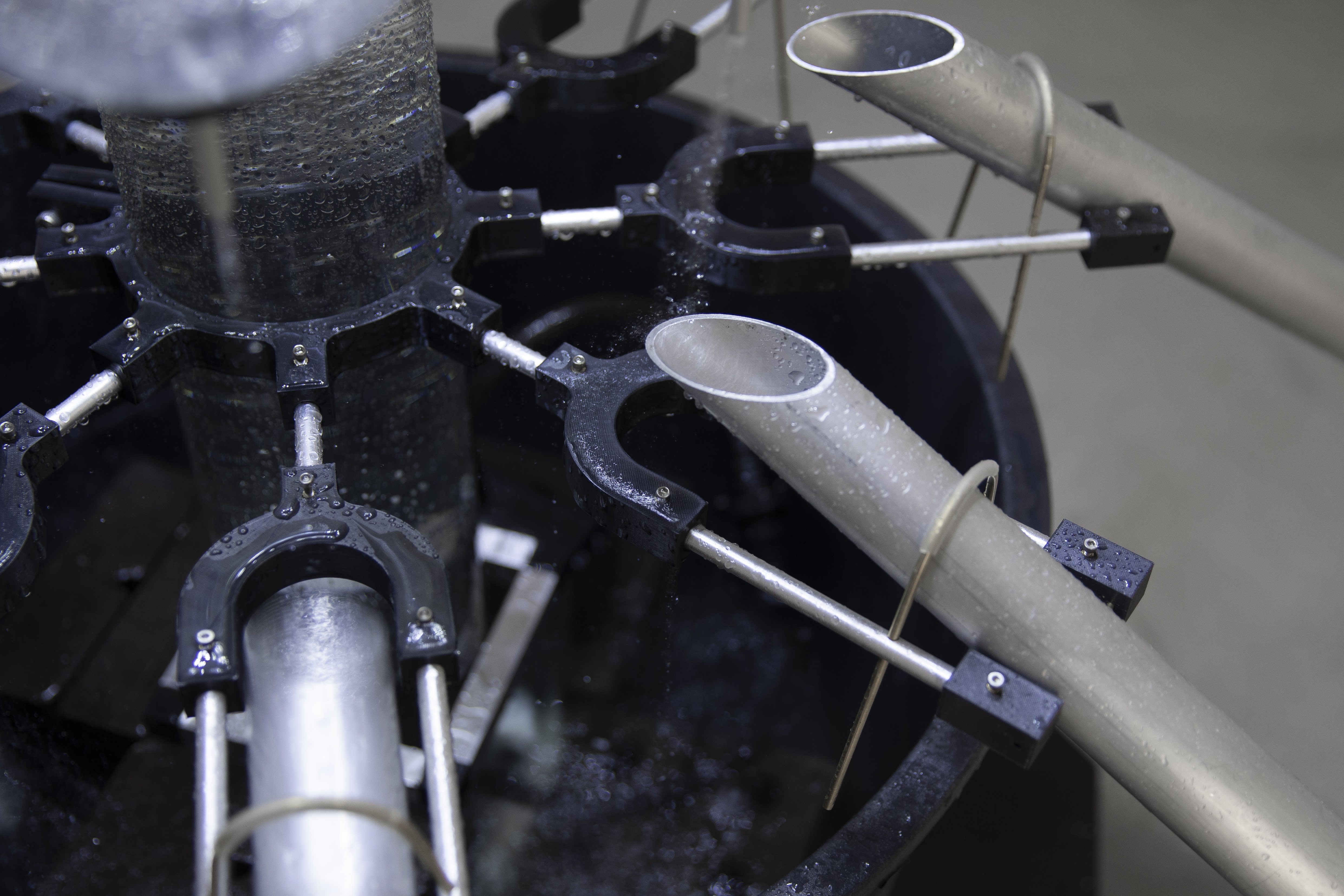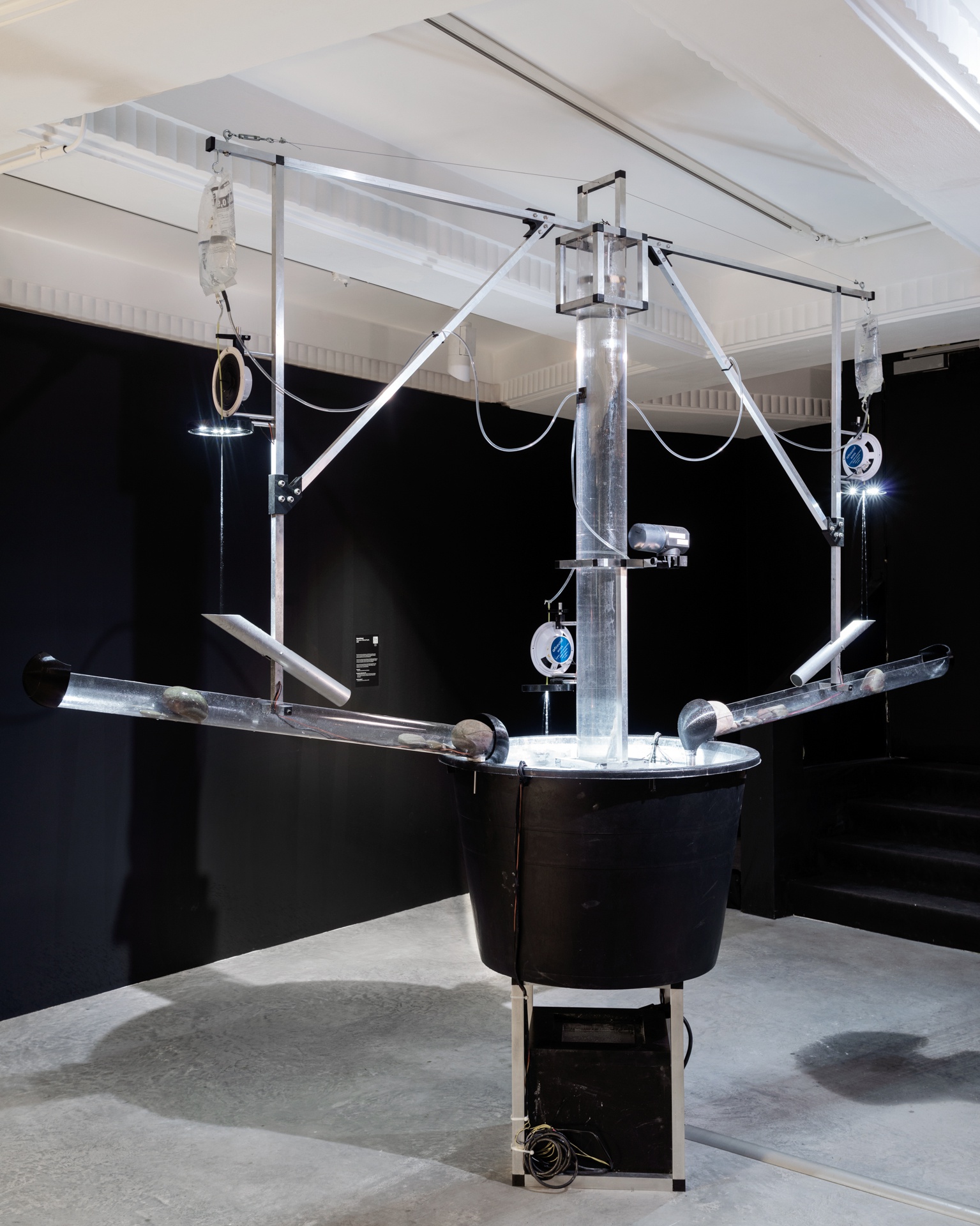STIRworld talked to Haseeb Ahmed about the series 'Fountains of Eternal Youth', which he presented in his last solo exhibition at the gallery, titled 18 Winds.
Read - or listen to - the full article by Manu Sharma here
Haseeb Ahmed's 'Fountains of Eternal Youth' explores pharma pollution in our waterways

Haseeb Ahmed, A Fountain of Eternal Youth II (Tower of Winds) (detail), 2022, installation view 18 Winds, Harlan Levey Projects 1080, 2023. Photo credit Adriaan Hauwaert
Ahmed tells STIR, “The pieces were conceived through my research residency on the topic of pharmaceutical pollution hosted at Gluon, a foundation in Brussels that is dedicated to artistic and scientific collaboration, along with LUCA school of arts, which is also in Brussels. It was funded through the STARTS4Water project through the EU Commission's Science Technology and Arts initiative.” The project took around nine months, from research to realisation, and was structured through six meetings with an expert group that Gluon had assembled. The group featured leaders in water treatment and pharmaceuticals, within which Flanders is particularly rich, owing to its extensive waterways and pharma production. Ahmed looks back, saying, “I tried to treat these meetings as workshop sessions with various brainstorming and model making activities. I would share art historical research and prototypes at each meeting as well, in order to create a situation in which their inputs could be transfigured to the artwork.”

Haseeb Ahmed, A Fountain of Eternal Youth III (Urinal), 2022, installation view 18 Winds, Harlan Levey Projects 1080, 2023. Photo credit Adriaan Hauwaert
Ahmed’s series is built upon a certain conundrum: that being the irony of our increasing reliance on pharmaceuticals to ensure long and healthy lives, while at the same time 90 per cent of pharmaceutical pollution comes from our own urine. What this means is potentially devastating for the ecosystem: the medication we eat does its intended work on the human body, but remains active afterwards as it enters the waterways. This affects bacterial, plant and animal life, in ways that we cannot yet understand the full extent of. Neither, as the artist points out, can we simply condemn pharmaceuticals, as they are a form of social wish-fulfilment. However, we must identify that they exist within a capitalist context, governed by massive companies. Ahmed adds an inconvenient truth to this: he points out that pharma companies grew especially powerful in recent memory, through funds that were gathered from government-mandated vaccines.

Haseeb Ahmed, A Fountain of Eternal Youth II (Tower of Winds) (detail), 2022, installation view 18 Winds, Harlan Levey Projects 1080, 2023. Photo credit Adriaan Hauwaert
Ahmed’s craftsmanship drew upon a totem of sorts, in order to begin thinking through the complex topic that 'Fountains of Eternal Youth' explores. This was the figure of the Yin and Yang, and the first prototype that he built featured water dripping into and being sucked out of a vessel in a closed system. He tells STIR, “As is the case with all of my work, I wanted to show the phenomena itself rather than a documentation of it. The water is infused with human growth hormone. A non-biodegradable widely used anti-aging supplement which is also largely unregulated. The non-biodegradability means that these compounds will only accumulate and enter everyone’s drinking water, and accumulate within our bodies over time. Pharmaceuticals are an often-unconsidered form of pollution. It is measured in water at parts per billion, or parts per billion of a pharmaceutical compound in a water sample. This figure stretches the limits of comprehension and approaches the sublime. Part of my task was to find a way to translate this quantity into a quality that could be experienced aesthetically by viewers in the gallery of the Bozar Center for Fine Arts in Brussels. I also wanted to avoid the trap that many art and science projects fall into, where the artist is relegated to merely visualizing scientific data.”

Haseeb Ahmed, A Fountain of Eternal Youth, 2022, installation view Faces of Water, Bozar, Brussels, 2022. Photo credit Johan Poezevara & Fabien Silvestre Suzor (J+F)
The artist sees the flow of water itself as becoming analogical in this series. He explains that he decided to develop a stroboscopic technique that would make it appear as though the water had stopped; halting or even reversing the flow of time. “However,” he says, “we know that time marches on. Just below the droplets, we can see and hear water-clocks filling and emptying. This contradiction is analogical to the contradiction of the desired effect we want pharmaceuticals to have on us, while we also know that they have other, more dangerous effects, on the environment.” Ahmed tells STIR that the flow of water has been associated with the flow of time since antiquity. He evokes the wisdom of Heraclitus, who stated that we cannot step into the same river twice, because we are not the same and nor is the river. This concept is known as Panta Rhei, which translates to “Everything Flows.” The artist says “regulating the flow of water was one of the earliest forms of time-keeping, and a water-clock was kept in the Tower of the Winds, an Ancient Greek building thought to be the world’s first weather station. This is testament to the long-held association of wind, water and time. The water clocks I used in this piece are modelled on Shishi Odoshi clocks often found in Japanese Zen gardens. In these gardens one can consider the conundrum of mortality. For me the fountains have a figurative element—some more than others. One is literally relieving themselves in a urinal while another has a cruciform layout. They are an opportunity to consider the impermanence of our lives and our attempts to hold onto time for as long as possible.”

Haseeb Ahmed
Ahmed ends his interview with STIR with a valuable reminder: He says, “We take water for granted. It is the basis for all life as we know it, and yet we use it as a solvent, as well as to drain and manage waste.” Exciting things are sure to come from the artist in the future.
'Fountains of Eternal Youth'was developed in collaboration with Micheline Verhaeghe of Pollet Water Group, Hemotech, Steven De Laet of Inopsys, Dirk Halet of VLAKWA, Inge Genné & Johan Ceulemans of VITO, David Gering of Pharma.be, Dries Laperre of Surplace, Justine Sauvage & Korneel Rabaey of Capture-UGhent, Jan Huygh of Atelier Vilvoorde, and Piero Bisello. With the support of Gluon and LUCA School of Art.
